SIS Multi User Licence: ABB TECHNOLOGY LTD.. 4/30/2012
INTERNATIONAL
STANDARD
ISO
10218-1
Second edition
2011-07-01
Robots and robotic devices — Safety
requirements for industrial robots —
Part 1:
Robots
Robots et dispositifs robotiques — Exigences de sécurité pour
les robots industriels —
Partie 1: Robots
Reference number
ISO 10218-1:2011(E)
© ISO 2011
�
SIS Multi User Licence: ABB TECHNOLOGY LTD.. 4/30/2012
ISO 10218-1:2011(E)
COPYRIGHT PROTECTED DOCUMENT
© ISO 2011
All rights reserved. Unless otherwise specified, no part of this publication may be reproduced or utilized in any form or by any means,
electronic or mechanical, including photocopying and microfilm, without permission in writing from either ISO at the address below or
ISO's member body in the country of the requester.
ISO copyright office
Case postale 56 • CH-1211 Geneva 20
Tel. + 41 22 749 01 11
Fax + 41 22 749 09 47
E-mail copyright@iso.org
Web www.iso.org
Published in Switzerland
ii
© ISO 2011 – All rights reserved
�
SIS Multi User Licence: ABB TECHNOLOGY LTD.. 4/30/2012
ISO 10218-1:2011(E)
Contents
Page
Foreword ............................................................................................................................................................iv
Introduction.........................................................................................................................................................v
Scope......................................................................................................................................................1
1
2
Normative references............................................................................................................................1
Terms and definitions ...........................................................................................................................2
3
Hazard identification and risk assessment.........................................................................................6
4
5
Design requirements and protective measures .................................................................................7
General ...................................................................................................................................................7
5.1
General requirements ...........................................................................................................................7
5.2
5.3
Actuating controls.................................................................................................................................8
5.4
Safety-related control system performance (hardware/software)....................................................8
Robot stopping functions.....................................................................................................................9
5.5
Speed control.......................................................................................................................................11
5.6
5.7
Operational modes ..............................................................................................................................11
5.8
Pendant controls .................................................................................................................................13
5.9
Control of simultaneous motion ........................................................................................................15
5.10 Collaborative operation requirements ..............................................................................................15
5.11
Singularity protection .........................................................................................................................16
5.12 Axis limiting .........................................................................................................................................16
5.13 Movement without drive power..........................................................................................................18
Provisions for lifting............................................................................................................................18
5.14
Electrical connectors ..........................................................................................................................18
5.15
6
Verification and validation of safety requirements and protective measures ..............................19
6.1
General .................................................................................................................................................19
Verification and validation methods..................................................................................................19
6.2
Required verification and validation .................................................................................................19
6.3
7
Information for use..............................................................................................................................20
7.1
General .................................................................................................................................................20
Instruction handbook..........................................................................................................................20
7.2
7.3
Marking.................................................................................................................................................21
Annex A (informative) List of significant hazards .........................................................................................23
Annex B (normative) Stopping time and distance metric.............................................................................28
Annex C (informative) Functional characteristics of three-position enabling device ...............................30
Annex D (informative) Optional features ........................................................................................................31
Annex E (informative) Labelling ......................................................................................................................33
Annex F (normative) Means of verification of the safety requirements and measures.............................34
Bibliography......................................................................................................................................................43
© ISO 2011 – All rights reserved
iii
�
ISO 10218-1:2011(E)
SIS Multi User Licence: ABB TECHNOLOGY LTD.. 4/30/2012
Foreword
ISO (the International Organization for Standardization) is a worldwide federation of national standards bodies
(ISO member bodies). The work of preparing International Standards is normally carried out through ISO
technical committees. Each member body interested in a subject for which a technical committee has been
established has the right to be represented on that committee. International organizations, governmental and
non-governmental, in liaison with ISO, also take part in the work. ISO collaborates closely with the
International Electrotechnical Commission (IEC) on all matters of electrotechnical standardization.
International Standards are drafted in accordance with the rules given in the ISO/IEC Directives, Part 2.
The main task of technical committees is to prepare International Standards. Draft International Standards
adopted by the technical committees are circulated to the member bodies for voting. Publication as an
International Standard requires approval by at least 75 % of the member bodies casting a vote.
Attention is drawn to the possibility that some of the elements of this document may be the subject of patent
rights. ISO shall not be held responsible for identifying any or all such patent rights.
ISO 10218-1 was prepared by Technical Committee ISO/TC 184, Automation systems and integration,
Subcommittee SC 2, Robots and robotic devices.
This second edition cancels and replaces the first edition (ISO 10218-1:2006), which has been technically
revised. It also incorporates Technical Corrigendum ISO 10218-1:2006/Cor.1:2007.
ISO 10218 consists of the following parts, under the general title Robots and robotic devices — Safety
requirements for industrial robots:
Part 1: Robots
Part 2: Robot systems and integration
iv
© ISO 2011 – All rights reserved
⎯
⎯
�
SIS Multi User Licence: ABB TECHNOLOGY LTD.. 4/30/2012
ISO 10218-1:2011(E)
Introduction
ISO 10218 has been created in recognition of the particular hazards that are presented by industrial robots
and industrial robot systems.
This part of ISO 10218 is a type-C standard as outlined in ISO 12100.
When provisions of a type-C standard are different from those which are stated in type-A or type-B standards,
the provisions of the type-C standard take precedence over the provisions of the other standards for machines
that have been designed and built in accordance with the provisions of the type-C standard.
The machinery concerned and the extent to which hazards, hazardous situations and events are covered are
indicated in the Scope of this part of ISO 10218.
Hazards associated with robots are well recognized, but the sources of the hazards are frequently unique to a
particular robot system. The number and type(s) of hazard(s) are directly related to the nature of the
automation process and the complexity of the installation. The risks associated with these hazards vary with
the type of robot used and its purpose, and the way in which it is installed, programmed, operated and
maintained.
Not all of the hazards identified by ISO 10218 apply to every robot, nor will the level of risk associated with a
NOTE
given hazardous situation be the same from robot to robot. Consequently, the safety requirements, or the protective
measures, or both, can vary from what is specified in ISO 10218. A risk assessment can be conducted to determine what
the protective measures should be.
In recognition of the variable nature of hazards with different uses of industrial robots, ISO 10218 is divided
into two parts. This part of ISO 10218 provides guidance for the assurance of safety in the design and
construction of the robot. Since safety in the application of industrial robots is influenced by the design and
application of the particular robot system integration, ISO 10218-2 provides guidelines for the safeguarding of
personnel during robot integration, installation, functional testing, programming, operation, maintenance and
repair.
This part of ISO 10218 has been updated based on experience gained in developing the ISO 10218-2
guidance on system and integration requirements, in order to ensure it remains in line with minimum
requirements of a harmonized type-C standard for industrial robots. Revised technical requirements include,
but are not limited to, definition and requirements for singularity, safeguarding of transmission hazards, power
loss requirements, safety-related control circuit performance, addition of a category 2 stopping function, mode
selection, power and force limiting requirements, marking, and updated stopping time and distance metric and
features.
This part of ISO 10218 is not applicable to robots that were manufactured prior to its publication date.
© ISO 2011 – All rights reserved
v
�
SIS Multi User Licence: ABB TECHNOLOGY LTD.. 4/30/2012
�
SIS Multi User Licence: ABB TECHNOLOGY LTD.. 4/30/2012
INTERNATIONAL STANDARD
ISO 10218-1:2011(E)
Robots and robotic devices — Safety requirements for
industrial robots —
Part 1:
Robots
1 Scope
This part of ISO 10218 specifies requirements and guidelines for the inherent safe design, protective
measures and information for use of industrial robots. It describes basic hazards associated with robots and
provides requirements to eliminate, or adequately reduce, the risks associated with these hazards.
This part of ISO 10218 does not address the robot as a complete machine. Noise emission is generally not
considered a significant hazard of the robot alone, and consequently noise is excluded from the scope of this
part of ISO 10218.
This part of ISO 10218 does not apply to non-industrial robots, although the safety principles established in
ISO 10218 can be utilized for these other robots.
NOTE 1
Examples of non-industrial robot applications include, but are not limited to, undersea, military and space
robots, tele-operated manipulators, prosthetics and other aids for the physically impaired, micro-robots (displacement less
than 1 mm), surgery or healthcare, and service or consumer products.
NOTE 2 Requirements for robot systems, integration, and installation are covered in ISO 10218-2.
NOTE 3
system-related hazards need to be considered during robot design.
Additional hazards can be created by specific applications (e.g. welding, laser cutting, machining). These
2 Normative references
The following referenced documents are indispensable for the application of this document. For dated
references, only the edition cited applies. For undated references, the latest edition of the referenced
document (including any amendments) applies.
ISO 9283:1998, Manipulating industrial robots — Performance criteria and related test methods
ISO 10218-2, Robots and robotic devices — Safety requirements for industrial robots — Part 2: Robot
systems and integration
ISO 12100, Safety of machinery — General principles for design — Risk assessment and risk reduction
ISO 13849-1:2006, Safety of machinery — Safety-related parts of control systems — Part 1: General
principles for design
ISO 13850, Safety of machinery — Emergency stop — Principles for design
IEC 60204-1, Safety of machinery — Electrical equipment of machines — Part 1: General requirements
IEC 62061:2005, Safety of machinery — Functional safety of safety-related electrical, electronic and
programmable electronic control systems
© ISO 2011 – All rights reserved
1
�
SIS Multi User Licence: ABB TECHNOLOGY LTD.. 4/30/2012
ISO 10218-1:2011(E)
3 Terms and definitions
For the purposes of this document, the terms and definitions given in ISO 12100 and the following apply.
3.1
actuating control
mechanical mechanism within a control device
EXAMPLE
A rod which opens contacts.
3.2
automatic mode
operating mode in which the robot control system operates in accordance with the task programme
[ISO 8373:1994, definition 5.3.8.1]
3.3
automatic operation
state in which the robot is executing its programmed task as intended
NOTE
Adapted from ISO 8373:1994, definition 5.5.
3.4
collaborative operation
state in which purposely designed robots work in direct cooperation with a human within a defined workspace
3.5
collaborative workspace
workspace within the safeguarded space where the robot and a human can perform tasks simultaneously
during production operation
3.6
drive power
energy source or sources for the robot actuators
3.7
end-effector
device specifically designed for attachment to the mechanical interface to enable the robot to perform its task
EXAMPLE
Gripper, nutrunner, welding gun, spray gun.
[ISO 8373:1994, definition 3.11]
3.8
energy source
electrical, mechanical, hydraulic, pneumatic, chemical, thermal, potential, kinetic or other source of power
3.9
hazardous motion
motion that is likely to cause personal physical injury or damage to health
3.10
industrial robot
automatically controlled, reprogrammable multipurpose manipulator, programmable in three or more axes,
which can be either fixed in place or mobile for use in industrial automation applications
NOTE 1
The industrial robot includes:
the manipulator, including actuators;
the controller, including teach pendant and any communication interface (hardware and software).
2
© ISO 2011 – All rights reserved
⎯
⎯
�
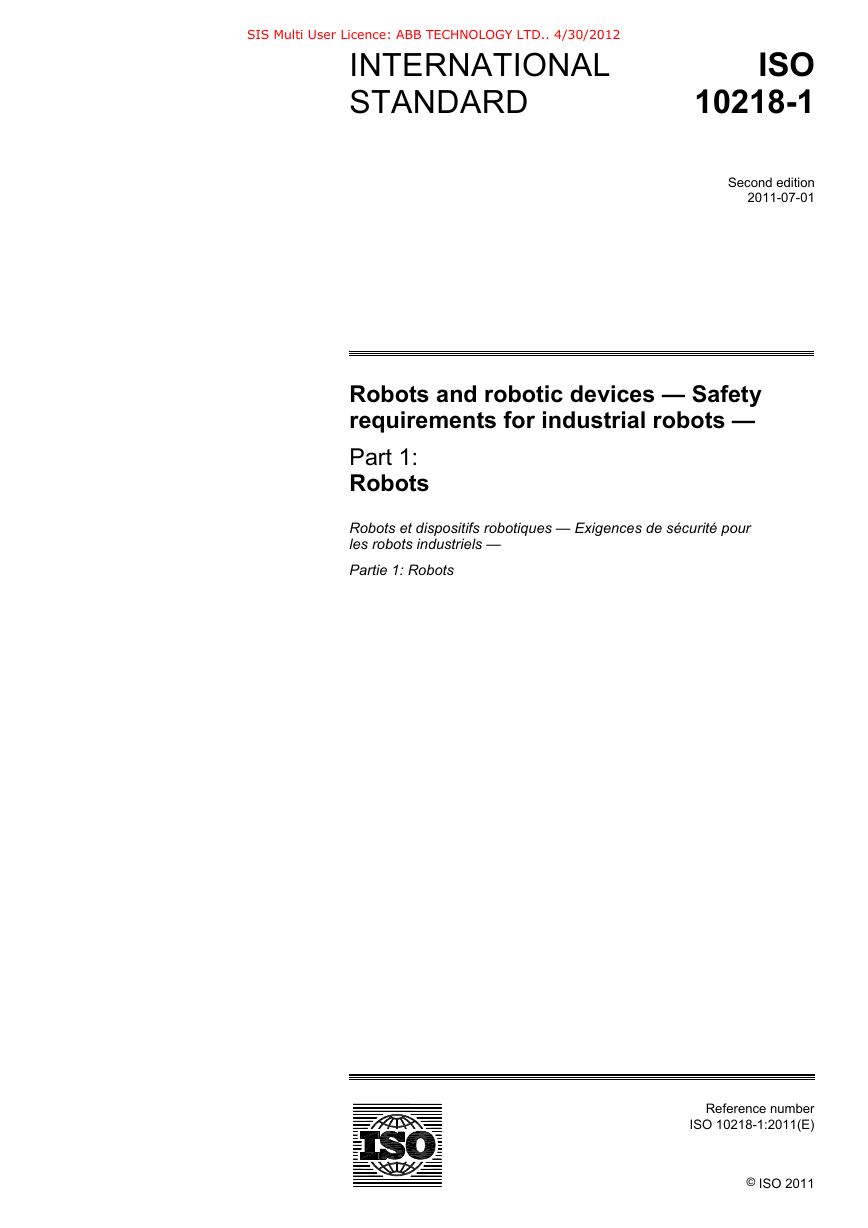

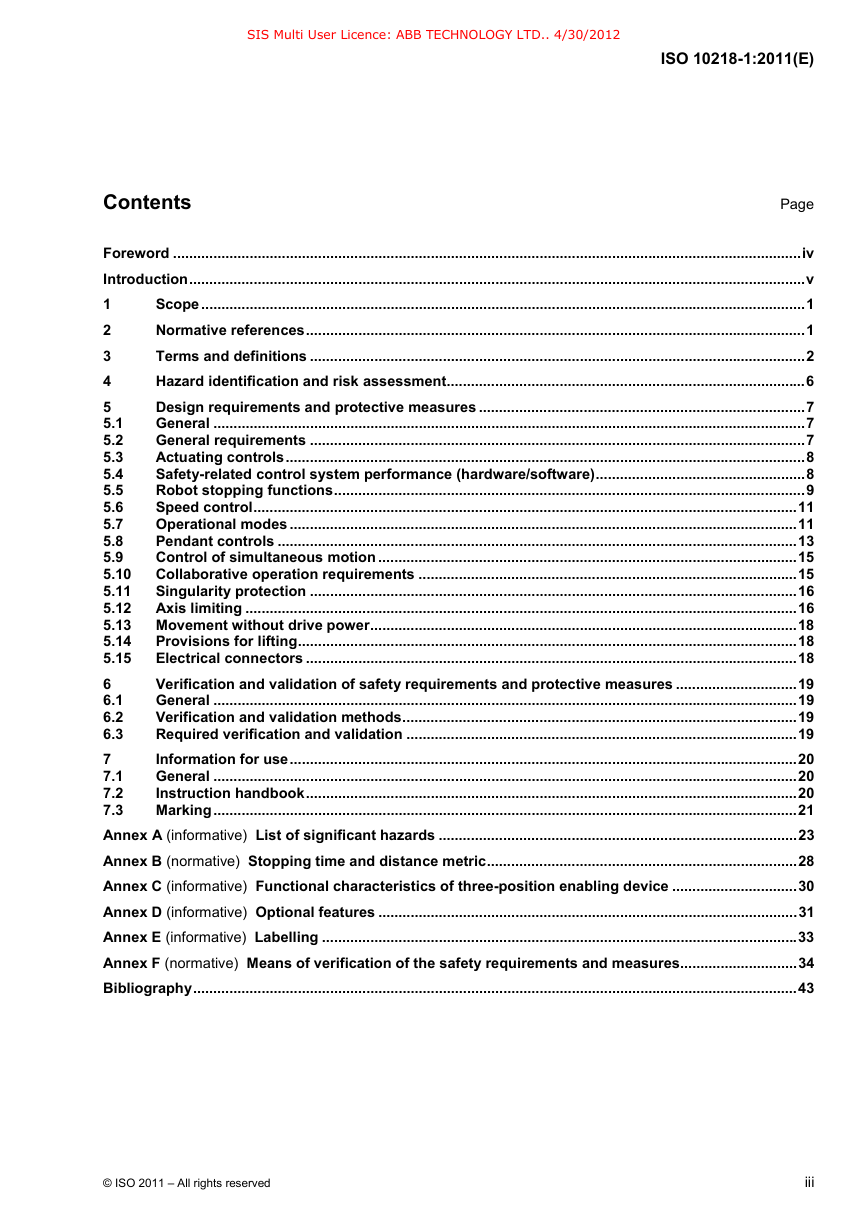
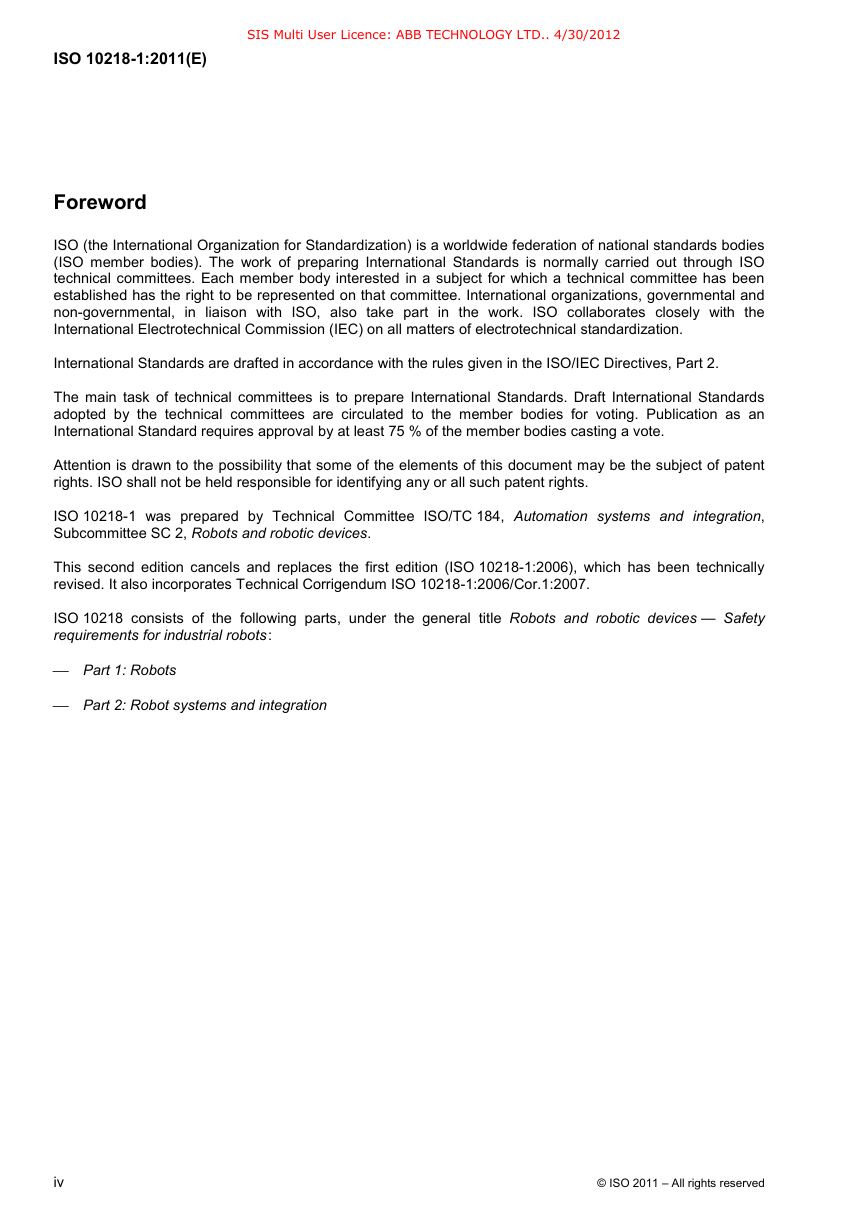


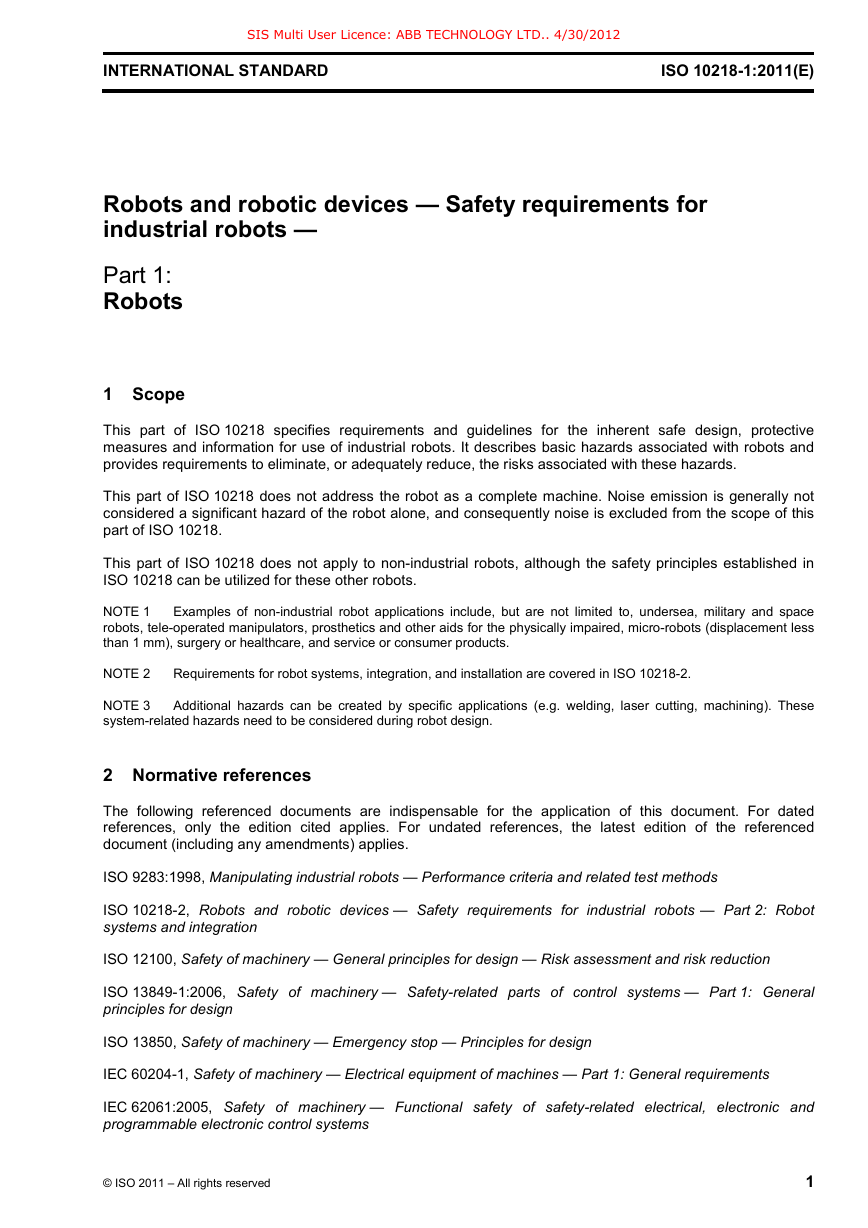
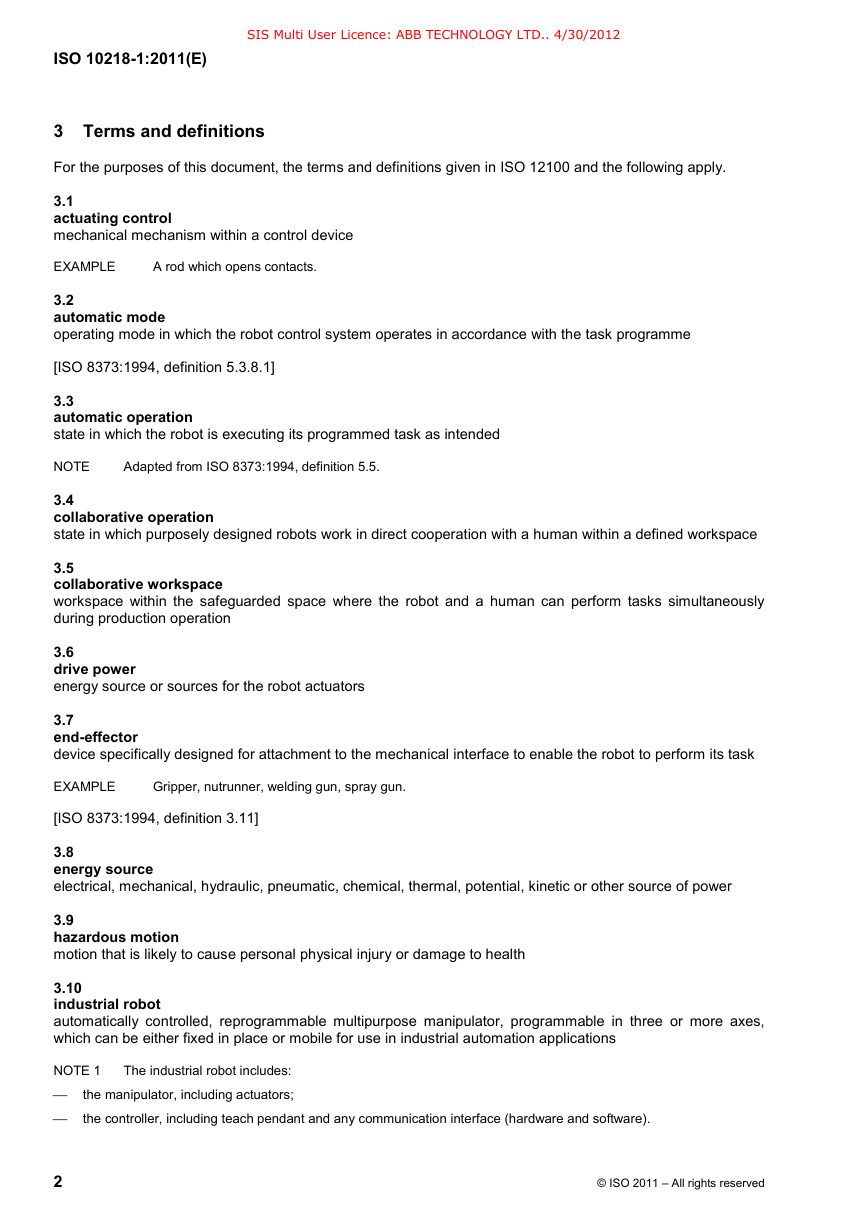








 2023年江西萍乡中考道德与法治真题及答案.doc
2023年江西萍乡中考道德与法治真题及答案.doc 2012年重庆南川中考生物真题及答案.doc
2012年重庆南川中考生物真题及答案.doc 2013年江西师范大学地理学综合及文艺理论基础考研真题.doc
2013年江西师范大学地理学综合及文艺理论基础考研真题.doc 2020年四川甘孜小升初语文真题及答案I卷.doc
2020年四川甘孜小升初语文真题及答案I卷.doc 2020年注册岩土工程师专业基础考试真题及答案.doc
2020年注册岩土工程师专业基础考试真题及答案.doc 2023-2024学年福建省厦门市九年级上学期数学月考试题及答案.doc
2023-2024学年福建省厦门市九年级上学期数学月考试题及答案.doc 2021-2022学年辽宁省沈阳市大东区九年级上学期语文期末试题及答案.doc
2021-2022学年辽宁省沈阳市大东区九年级上学期语文期末试题及答案.doc 2022-2023学年北京东城区初三第一学期物理期末试卷及答案.doc
2022-2023学年北京东城区初三第一学期物理期末试卷及答案.doc 2018上半年江西教师资格初中地理学科知识与教学能力真题及答案.doc
2018上半年江西教师资格初中地理学科知识与教学能力真题及答案.doc 2012年河北国家公务员申论考试真题及答案-省级.doc
2012年河北国家公务员申论考试真题及答案-省级.doc 2020-2021学年江苏省扬州市江都区邵樊片九年级上学期数学第一次质量检测试题及答案.doc
2020-2021学年江苏省扬州市江都区邵樊片九年级上学期数学第一次质量检测试题及答案.doc 2022下半年黑龙江教师资格证中学综合素质真题及答案.doc
2022下半年黑龙江教师资格证中学综合素质真题及答案.doc